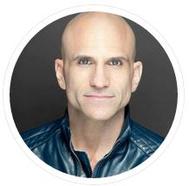
Michael Port's webinar was on "How to use Books to Book Yourself Solid & Grow Your Speaking, Coaching & Training Business (and a sneak peek of my new, unreleased book)".
Michael's interview was based on two main parts: his writing process and the different structures he uses, and his promotional strategies that lead to the sales process.
Michael is a very successful author - five times Yew York Times bestseller and hit #2 on Amazon in the world - as well as a marketing and sales guru. However, his structures and strategies can be applied by first-time authors in writing and promoting their books.
Over time he's learned how to organize information very well and there are a number of structures that he relies on depending on the book he's writing. Interestingly, he uses these same structures or frameworks for his speeches, courses, coaching programs and information products.
Let's take a look at them:
- the modular framework: he takes his ideas and organizes them into modules; an example of this is his upcoming book, Steal the Show, where he's careful about which concept to introduce first, second, third... within each module
- the chronological or sequential framework, it's a step-by-step process: step 1, step 2, step 3...
- the numerical framework allows the reader to follow any order s/he pleases, making it easy to understand the content
- the compare and contrast framework based on comparing two groups of things, one good and the other great, and showing what's similar and different; the reader's job is to take what's different and apply it to whatever s/he's dealing with to make it great; the example he used to illustrate this structure was Jim Collins' book, Good to Great, which compares companies
- the problem-solution framework in which you identify "x" number of problems and offer a solution for each; it can be combined with the numerical framework
- the combined framework, a combination of two structures such as modular and sequential or numerical
- the reference framework which is like a reference book, just lists of things
- the three-act framework based on exposition, story and resolution.
Many of us will recognize some or all these frameworks in books that we've read.
Like several others at this summit, Michael also puts great emphasis on the backend of books: repurposing content to leverage them financially, monetize them through courses, coaching, public speaking, keynotes...
For him, the biggest driver of sales is the book, a must! The book is his platform. The promotional strategies, everything else around the book, are choices: ads, speaking, blogging, podcasting, writing articles. They're tools that help him promote his books and get people into his products and programs.
The focus of his business is making each of his books a bestselling evergreen book. And that is the long game, promoting it until it becomes evergreen.
Referring to the sales process, he brought up a different and interesting perspective. He says that we shouldn't assume that everybody buys the same way, in the same pattern or at the same speed. So he doesn't see the sales process as a funnel, but rather as a merry-go-round where people get on or off wherever they want, switch horses when they want and stay on as long as they want. So every so often you, the sales person, have to get in touch with them and ask: "Are you interested?"
His final piece of advice for first-time writers:
- don't be a perfectionist
- finish your book when you say you're going to: public accountability and committing to a date
- sell it before you've written it! [Yet another one saying this!]
Thanks for a great "performance", Michael! Very interesting food for thought!

 RSS Feed
RSS Feed
